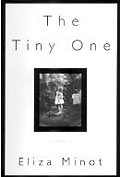AT EIGHT YEARS OLD, Via Revere receives the shock of her life: Her mother has been killed in a car accident. But instead of dwelling on her loss, Via grasps onto the memory of her mother, painstakingly recording all she can.
THE TINY ONE by Eliza Minot (Knopf, $22)
In the language of a child, first-time novelist Eliza Minot (sister of novelist Susan) relates the grief and bewilderment of death. After Via reminisces about snuggling in bed with her Mum—who “smells good like grass and oranges”—she wonders, “if I didn’t remember that time, it would have just, like—poof—no one would ever have known? It’s just weird. She dies. She goes to heaven. Or wherever. But where do all the things she thinks go? . . . Where do all of when she thinks of me go?”
Via’s school day—the hours before she receives the dreadful news—serves as the book’s framing device, each chapter beginning with a classroom scene. The most powerful emotions, however, are conveyed by her reveries, gathered and strung across the pages like pearls. As if playing on the nurturing connotations of “la mer,” Minot sets many of Via’s memories near the ocean, relating life in a seaside community in Massachusetts, sailing and digging for clams, or vacationing in Bermuda, where large crabs crawl across the lawn.
Minot’s language is simple but evocative, turning the child’s small pleasures into rich, sensual experiences: “The banister . . . has paint that’s excellent to peel. It’s soft and gray and rubbery so it comes off in nice loose strips like moist skin.” When Via eats a cucumber slice, Minot writes, “Outside it was winter but in my mouth it tasted a little bit of spring. It was sweet.”
The book’s one weakness is its episodic structure. Minot composes less a story than a scattered collection of pictures that are tangentially related at best; while vividly described, their lack of a narrative pull often makes for hard going. Via jumps back and forth in time, location, and subject—moving in no apparent direction except to give more slices of her life. While this reflects the real-life process of memory, some of the book’s scenes seem gratuitous and confusing. Many end abruptly, making you wonder what happened next—but no follow-up is supplied. Still, such flaws are forgivable, as it’s hard not to like Via, who is perceptive, funny, and, above all, brave enough to salvage joy in the face of tragedy.







